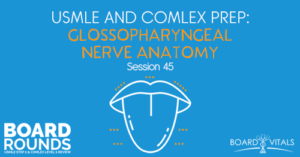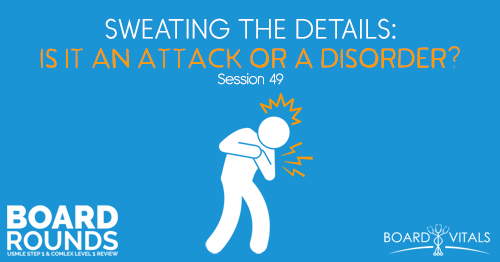Apple Podcasts | Google Podcasts

Session 45
Where does the branchial motor component of the glossopharyngeal nerve originate? Join us and see how well you know your neuroanatomy.
If you are looking for some other podcasts, check out Specialty Stories, a great podcast to help you figure out what specialty you will want to practice in the future.
I’m joined by Dr. Mike Natter from BoardVitals. Check them out if you are looking for some more help with your board prep. Their massive QBank database will help you prepare for Step 1 or Level1 and even in the future as well for your Shelf exams. Use the promo code BOARDROUNDS to save 15% off.
Listen to this podcast episode with the player above, or keep reading for the highlights and takeaway points.
[02:32] Question of the Week
Where does the branchial motor component of the glossopharyngeal nerve originate?
(A) Inferior salivary nucleus
(B) Nucleus tractus solitarius
(C) Spinal nucleus of the trigeminal nerve
(D) Dorsal nucleus of the vagus
(E) Nucleus ambiguus
[06:37] Thought Process
The correct answer here is E.
Here’s a nice way to memorize this. For pre-meds to get into medical school, they have to have a strong GPA. And GPA for glossopharyngeal ambiguus.
Last week, we talked about it C the spinal nucleus of the trigeminal nerve, that’s where I have a lesion. When we talk about the salivary nucleus, we’re talking about these like visceral motor fibers of the glossopharyngeal coming out of the spinal nucleus. They provide the parasympathetic.
But the branchial are coming out of the glossopharyngeal ambiguus. So let’s rephrase the GPA mnemonics that we mentioned above so it won’t confuse. We are going to have to add an extra kind of caveat to that. So we suddenly have to add in the branchial motor of the GPA. So you want higher than a B.
For B, the visceral sensory fibers that ascend to the inferior glossopharyngeal ganglion. They enter the skull to the jugular foramen until they’re passing from the lateral medulla and synapsing. The solitary nucleus is one of the reasons that you vomit. There are two areas in the brain that are related to that. One is in the fourth ventricle and then the other one is this solitary nucleus that’s outside the broad blood-brain barrier. That’s why it helps us puke if we need to.
For C, the somatic sensory fibers, the middle ear, they synapse in the spinal nucleus of the nerve and D, the bronchial motor fibers, the vagus nerve originating in the dorsal motor nucleus.
[09:01] Final Thoughts
It’s impossible to truly memorize all of the nucleus, all of the nerves. But if you just allocate a certain amount of time to try and memorize them, and then chalk it up to saying you’re not going to waste time.
You’ve reviewed it and then, hopefully, that when you recall in the STEM or when you see it again, you can kind of recall this information. It’s just not worth spending weeks and months memorizing the nuclei.
Unfortunately, there are diminishing returns. After a while, you’re wasting precious time studying something else that may make more sense and that you don’t need to memorize.
Links:
BoardVitals (Use the promo code BOARDROUNDS to save 15% off.)
SEARCH SITE
LISTEN FOR FREE











